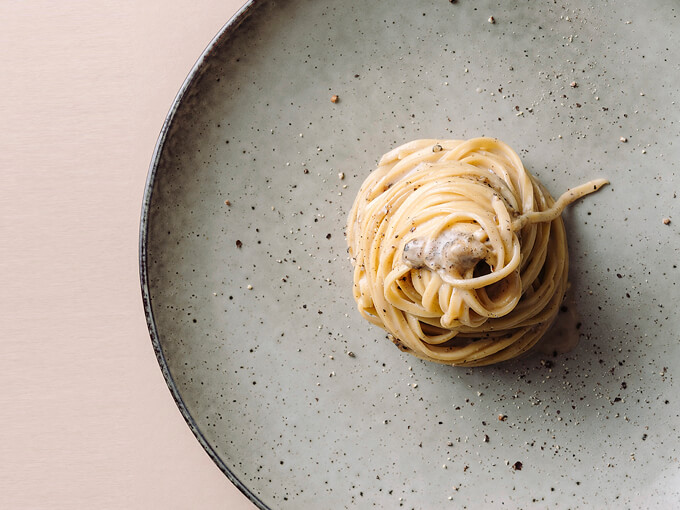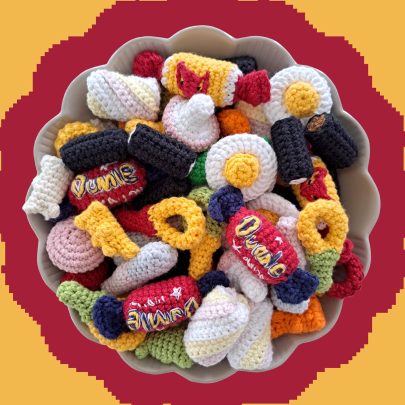Oct 9, 2019 Food
Jean Teng becomes bewitched by a pasta dish with just three ingredients. She searches the city high and low to find the perfect cacio e pepe (fun to say, yum to eat), but the task proves tricker than she thought.
Scroll to the bottom to learn how to make your own cacio e pepe at home, with a recipe from the head chef and owner of Pasta & Cuore, Stefania Ugolini.
Sounds simple, right? Yet finding the perfect cacio e pepe is a challenge.
In Ancient Rome, circa sometime BC, cacio e pepe was the dish of shepherds. They would accompany their grazing sheep as they munched through the Apennine Mountains, and would carry some hard, aged pecorino, pepper and dried pasta to fuel their herding.
Thousands of years later, in New York, circa 2016, it became the dish of exposed-brick bistros lit with Edison bulbs. Long strands of pasta glistened on our Instagram feeds, speckled with what seemed like an excessive amount of cracked black pepper. TimeOut called it “New York’s trendiest dish of 2016”. As Momofuku’s David Chang said, “Salt, spice, umami, dairy, and texture. It’s in the pantheon of perfect dishes. You cannot make cacio e pepe better.” Yet, he tried, and perhaps succeeded. Momofuku Nishi’s “ceci e pepe” — using a fermented-chickpea paste instead of pecorino — became a social-media sensation. Other restaurants started to remix it — cauliflower, brussels sprouts, anchovies all made an appearance. It is, after all, a dish begging to be messed with.
But I craved it at its most modest, those close-ups of hypnotic swirls dreamily shimmering over and over again in my mind. I’d imagine hoovering it up like the vacuum in Teletubbies.
For more great videos, check out our Youtube Channel.
There are just three ingredients: pecorino romano cheese, black pepper and pasta. Four, if you include the pasta water essential to achieving that smooth creaminess the dish is known for. Three ingredients. But, key to its mysterious allure, it’s also deceptively hard to make. Cacio e pepe is the favourite pasta dish of Samin Nosrat — of Salt, Fat, Acid, Heat fame — despite her lamenting in the New York Times of many failed attempts, the cheese curdling no matter how much she tried. There’s a lot of stirring involved. In some restaurants in Rome, they’ve started to use immersion blenders to achieve that sought-after creaminess, rather than stirring by hand and risking that curdle.
Cacio e pepe blew up in Australia, particularly Melbourne, last year, but never quite made it to Auckland. Why not? It could be that I couldn’t find a single Roman chef here, or that people are put off by its monochromatic simplicity. I could find only four restaurants which did a version of it. And, determined in my quest, I ate at every single one.
First up was Amano , a crowd-favourite Italian-ish eatery which seems to never have had an empty table during business hours since its opening in 2016. Amano’s cacio e pepe was made using rigate, a chunky tubular penne with a chewy bite. This did absolutely nothing in the way of fulfilling my strand-slurping fantasies, but oddly, it worked. Though the sauce had less to cling onto than it would with spaghetti, and the finely ground pepper didn’t seem strong enough, the taste was good.
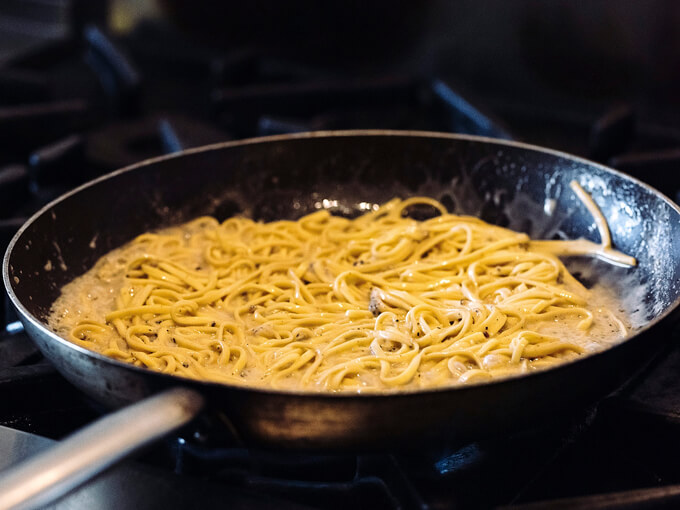
Baduzzi was next. I was so bereft after eating the “spaghetti cacio & pepe” here, I ordered a tiramisu with my own money and ate it morosely, alone, among all the blue-blazered businessmen. This was not cacio e pepe; it wasn’t even spaghetti. The pasta was intertwined into one giant clump — so much so a server saw me struggling and brought a spoon over — with way too much olive oil and just a sprinkling of grated pecorino on top. If the staff didn’t reassure me, I would have been convinced it was parmesan, without any of the great funkiness of pecorino (made from sheep’s milk rather than cows’). It probably was because there was so little of it. Everything was a lie. Next.
Non Solo Pizza’s cobbled courtyard out back speaks to a fantasy of rich women all dressed in white linen, and I felt immensely grubby after having a well-coiffed host flick a napkin into my lap. For lunch! The cacio e pepe brought out looked the most alike to my objects of lust on social media, albeit with pesky microgreens and grated zest powdered over it, transforming it from a warming Roman staple to a summery, vineyard-adjacent fancy. It was good: the pecorino had been well combined with pasta water, but there wasn’t enough cracked pepper, and the zestiness made it two steps removed from the cacio e pepe of my dreams.
Vic Road Kitchen has an Italian waiter. He tells me that cacio e pepe is what he’d order, and, sadly, I’ve got to admit that it does indulge my arbitrary desire for authenticity. When it comes to me, it looks the part, but the strands are cooled and it’s ended up slightly gluggy rather than creamy, the excess of pecorino shavings on top perhaps ruining it after I’ve folded it in. It also has truffle oil, which does add flavour, but the wrong flavour. I’m told that in Italy they will sometimes shave fresh truffles on top, but, if it needs to be said, truffle oil does not equal fresh truffle.
I ended my journey with more questions than answers. First, is it polite or problematic to pronounce cacio e pepe with an — perhaps unavoidably comical — Italian accent? (And with an Italian-chef kiss of the fingertips?) Second, was social media — surprise, surprise — and all its glitzy razzle-dazzle setting me up for disappointment? How, exactly, can reality live up to something David Chang calls “the pantheon of perfect dishes”? Thirdly, what does a girl have to do to get a decent plate of cacio e pepe in Auckland?
To answer the last question, I reached out to an Italian chef and convinced her to make the dish especially for me.
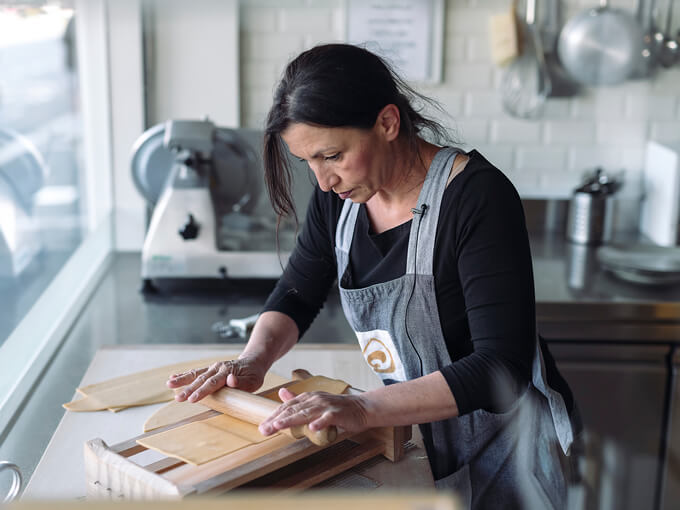
Pasta & Cuore head chef and owner, Stefania Ugolini, landed from Italy this morning. Fresh from eating cacio e pepe in the motherland, she’s pressing fresh dough into the strings of a chitarra (“guitar”), letting the strands fall into a heap. This way of making spaghetti, called spaghetti alla chitarra, makes the strands square and is a favourite of Rome, said to hold the creamy sauce better.
First, the pepper should be coarsely ground just before you use it, to get the richness of flavour. When she tosses the lot into the pan, a huge whiff of it is thrown up into the air immediately. There’s a lot of it. Next, she tells me to put less salt in the boiling pasta water — the cheese is salty enough.
Ugolini’s recipe uses half pecorino romano and half parmigiana-reggiano (or grana padano — similar to parmigiana, but from a different region in Italy — they’re very particular about that), which will upset some traditionalists. It mellows out the tangy sharpness of pecorino, and tastes a bit more “cheesy”. I had been building the stirring of the cheese and pasta water up in my mind as a culinary tight-rope walk, but, apparently, it’s no big deal. Ugolini shows me the bowl of combined pasta water and grated cheese paste: “It’s good, no?”
She takes the pan off the heat, mixes the cheese with the pasta, then puts it back on the heat, mixes some more. When I ask why she likes the dish, she says something beautiful in Italian I can’t understand, but which I’m sure includes the word “magic” somewhere. In the end, she says, “We have just five ingredients on this plate: egg, flour, cheese, pepper and salt.” And, she continues emphatically, “I think it’s really nice.”
Tossing the pasta over and over again, she lifts the pan from the heat and swiftly, expertly, jerks it back and forth, the pans clattering. She puts the pan down again, then looks at me. “I think it’s ready.”
I swirl the strands around my fork (it goes on and on) and the first thing I taste is pepper. Freshly ground pepper, reduced with pasta water, is surprisingly spicy. The creamy sauce, evenly dripped down the strands, was perfect for slurping, not too wet, ending in delightful bites on al dente spaghetti. I couldn’t get over that overly-peppery flavour hit, and with the cheese making it sharp, spicy, moreish, and delicious.
I can’t believe this isn’t on a menu.
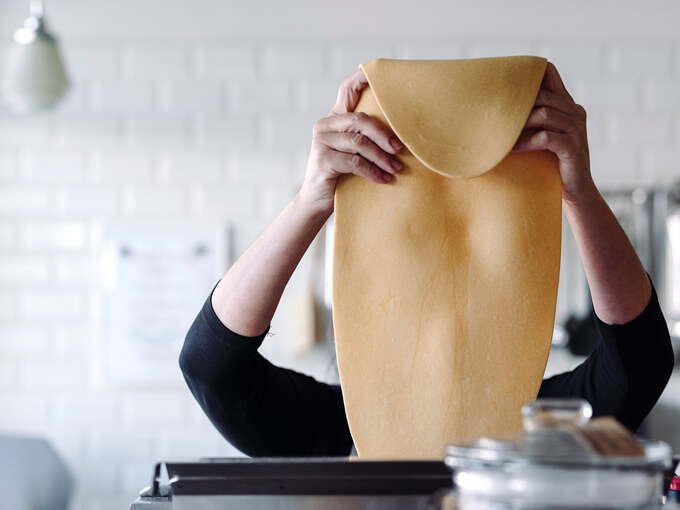
Make your own cacio e pepe at home, with Stefania Ugolini’s recipe
Ingredients
Spaghetti: 200g
Pecorino romano: 100g grated (or 50/50 mix pecorino and parmigiana)
Black pepper: 1 Tbsp, crushed with a mortar and pestle
Directions
Crush the pepper to coarse grains using mortar and pestle. Place pepper in a pan large enough to contain the pasta and toast over a medium heat.
At the same time, bring a large pot of water to boil with sea salt. Once boiling, put the pasta in and stir.
After two minutes, transfer two ladles of boiling water into the pan with the pepper and mix. Raise the heat and boil so the water reduces slightly.
Place the grated cheese into a mixing bowl. Take some water from the cooking pasta (one or two spoonfuls) and mix well with a spatula until the cheese forms a creamy paste (add more water if needed).
Remove the pan containing the pepper from the heat. When the pasta is cooked al dente, strain and mix the pasta into the pan with pepper. Place the pan back on a medium heat and mix in the cheese paste so the spaghetti is covered.
Plate with a little cracked pepper sprinkled over the top and serve immediately.
This piece originally appeared in the September-October 2019 issue of Metro magazine, with the headline “Cheese and pepper”.

